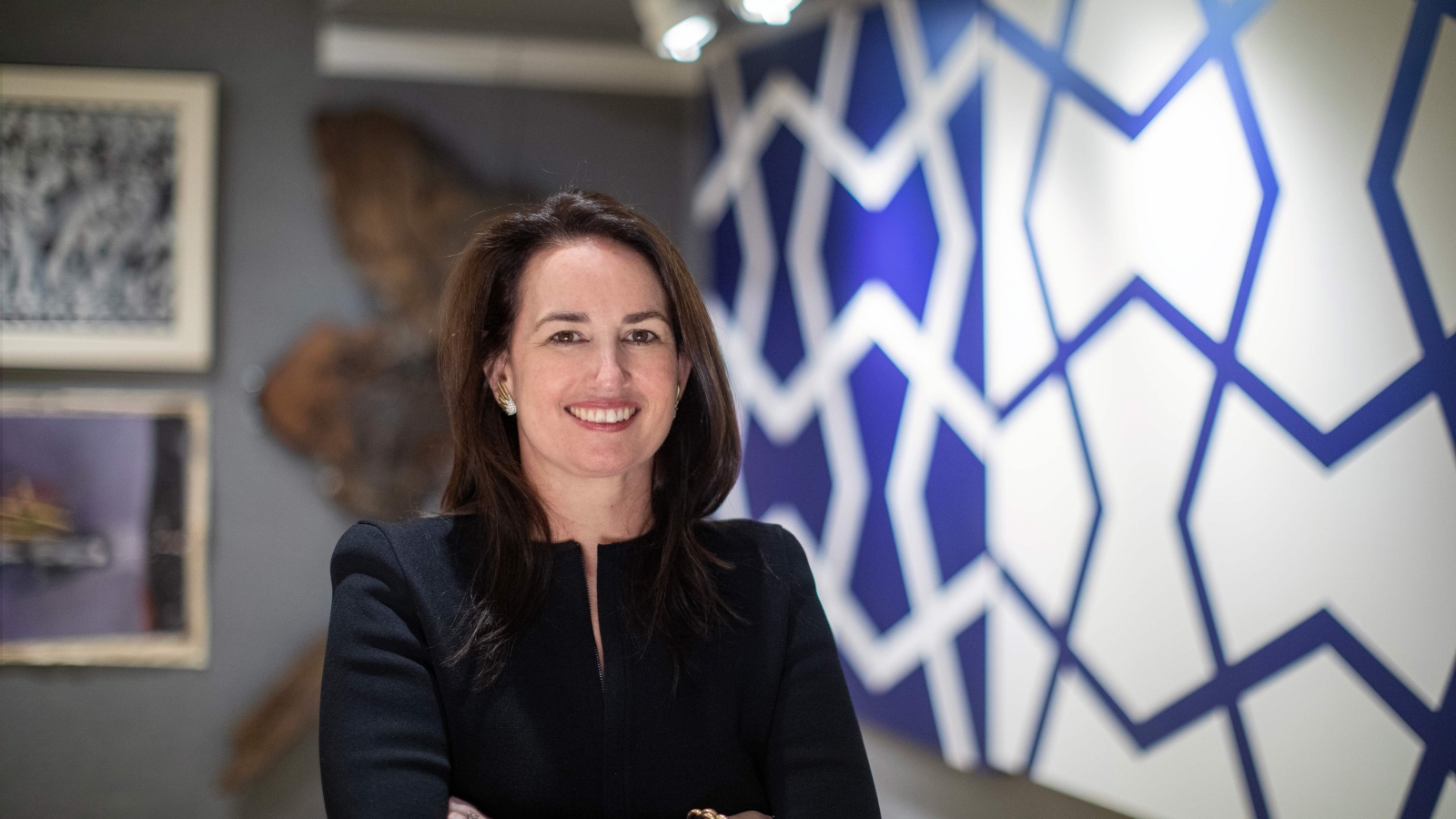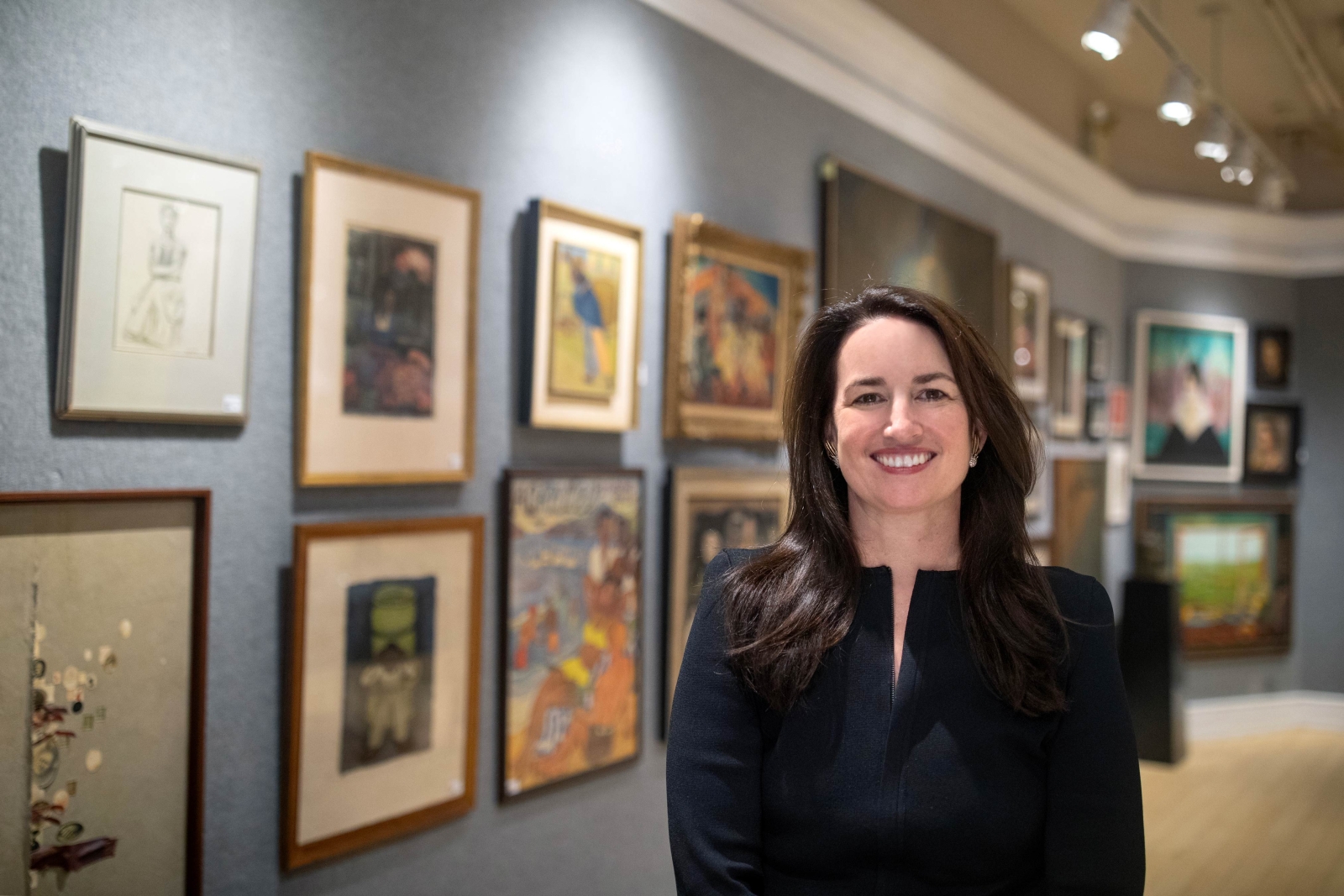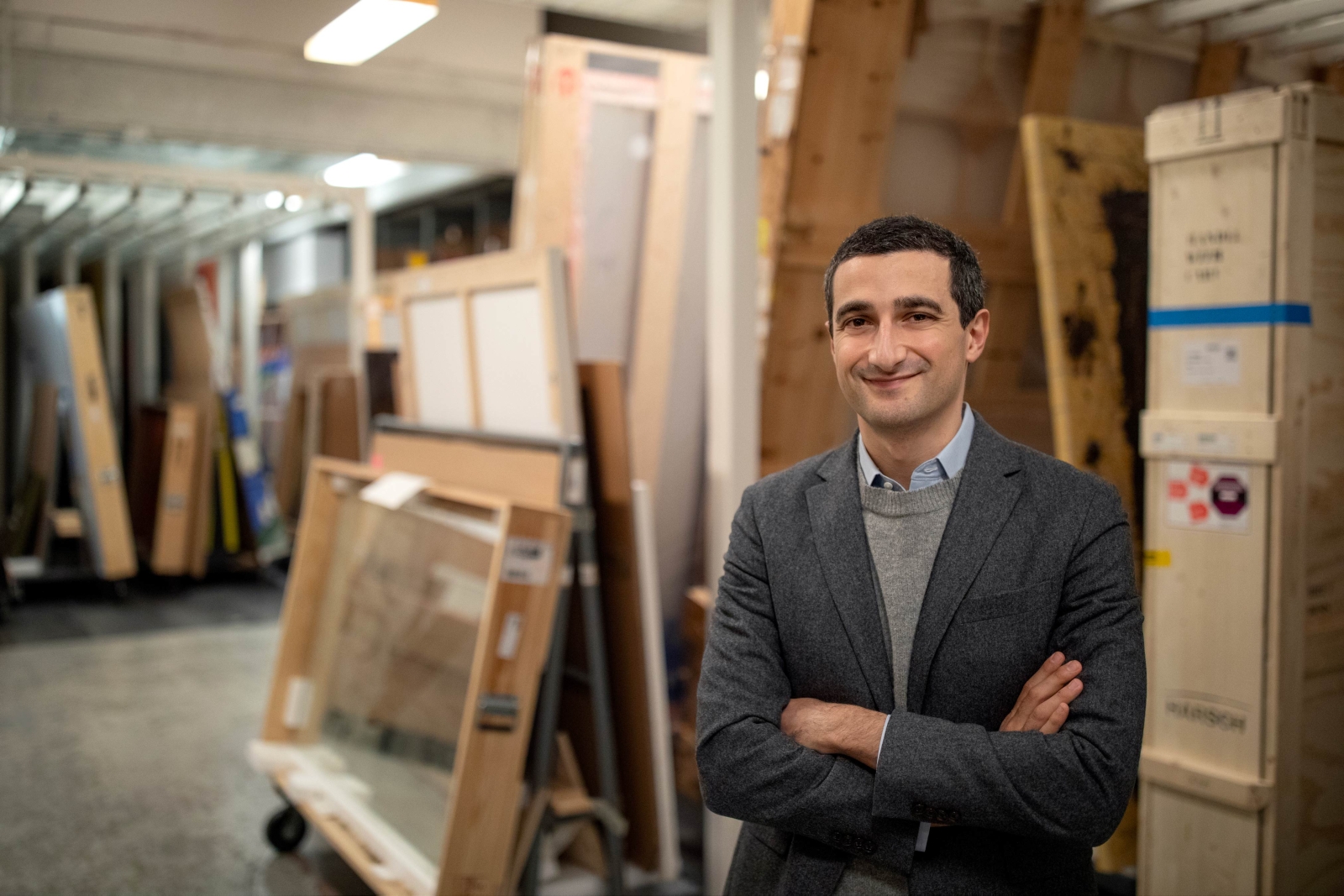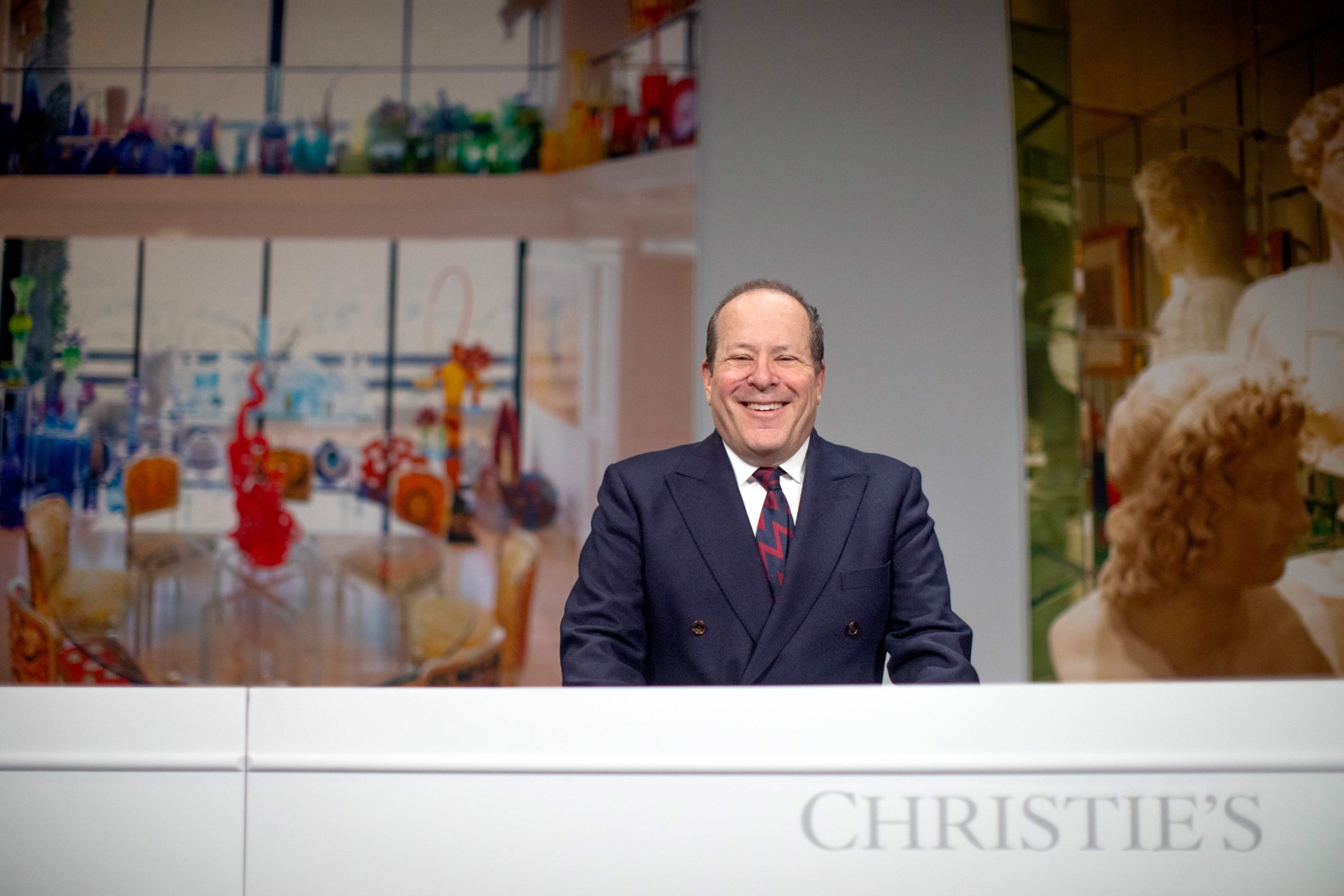Guardians of the Gallery
Alums now at Christie’s, Sotheby’s, and Doyle auction houses discuss championing underrepresented artists, enriching an object’s narrative, their time at Penn, and more.

On a mid-November evening, David Galperin, C’13, W’13, sits in the first row of what looks like a pared-down stadium box at the Contemporary Evening Auction at Sotheby’s New York. Across from Galperin and colleagues, two rows of bidders fill another box. Others sit in central folding chairs, there to buy—or perhaps simply view—works from Jean-Michel Basquiat, Andy Warhol, Georgia O’Keeffe, Alice Neel, and a handful of other artists.

David Galperin, C’13, W’13 (center, green tie), a senior vice president at Sotheby’s, oversees contemporary art for the Americas, one of the largest collecting categories and biggest sale centers globally. “One of the great privileges is to get to work with such interesting people who share a passion for contemporary art,” he says.
Courtesy of Sotheby’s
Though the big names draw the crowds, Galperin, Sotheby’s senior vice president and head of contemporary art for the Americas, has always been interested in championing artists from undervalued or underrepresented groups. “Everyone knows Andy Warhol and Pablo Picasso,” he says, “but there are so many more stories to tell.”
Through his work for the auction house, Galperin has the platform to highlight such artists, much in the same way that Marc Porter, C’82, W’82, chairman of Christie’s Americas, has focused significant thought on art reparations and, separately, LGBTQ+ rights. Or how seriously Laura Doyle, C’00, CEO of Doyle auction house, takes the role that a business like her family’s can play in keeping items from a landfill.
“The danger with the art market is that it could stare at its own navel and not actually bring in the people it should,” says Jonathan Katz, an associate professor of practice in Penn’s History of Art Department. “But with progressive voices in this space, we can start to bring attention and scholarship to artists and art that have been neglected.”
Porter, Doyle, and Galperin represent that movement, a trio among many Penn Arts & Sciences alums in the art auction world, motivated to enter this line of work by inspiring professors and intriguing college courses, spurred by a love of art and proximity to Philadelphia’s art scene. “At Penn, you learn with a purpose,” Doyle says. “Everything is imbued with that sentiment, that feeling of ‘what’s next?’”
‘Custodians of the Objects’
Doyle auction house started as an antique store in 1962, the vision of Doyle’s father, William. It became a full-service auction house in 1973. When Doyle was just three, her dad began introducing her as the daughter who would someday take over the business. “Maybe I was his last hope,” she jokes, then adds, “It’s always been on my mind as a dream to fulfill.”

Laura Doyle, C’00, CEO of Doyle auction house, has been part of the family business since she was 8, working with her father after school. Today, she runs a company that offers more than 100 sales annually. “It’s such a fun business,” she says. “You never know what you’re going to find.”
Five years ago, she became CEO after stints at the front desk, in client services, and as a regional head. Today she works alongside her mom, Kathleen, who is chairman. “We’re a middle market auction house,” Doyle says. “Our biggest categories are jewelry, art, furniture, books, and coins.”
But as fascinating as such items are at face value, Doyle’s dad always found their backstories as intriguing—a mentality Doyle says she tries to uphold. She recounts one of her favorite family anecdotes about an item her father once sold: In a hidden drawer on the side of an English rent table (used by landlords to collect rent checks), he found a copy of Abraham Lincoln’s final speech.
There are many tales that equally stir the imagination. In the 1980s, for instance, Doyle auction house sold the jewelry collection of Louis Armstrong’s wife; in 2020, it handled the estate of Rosalind P. Walter, namesake of Rosie the Riveter. “We’re just borrowing these objects,” Doyle notes. “Every time one gets passed on, that adds to its story.”
Sometimes owner and object are forever intertwined, like the Basquiat painting called Air Power previously belonging to David Bowie and auctioned by Sotheby’s in 2016. “It will always be the ‘Bowie Basquiat,’” Galperin says. “There are all of these different examples where the identity of the collector and the history of an object’s ownership are so fused with the object itself that it really enriches the narrative.”
We’re just borrowing these objects. Every time one gets passed on, that adds to its story.
All of this is central to the story of the creative force behind a work, Galperin adds. “Objects outlive people, and so we are their custodians for a short period of time. We have the great advantage and privilege of bringing these objects from one part of the story to the next.”

Galperin says he’s always had an interest in making an impact that extends beyond the auction house, something he does today, in part, by championing artists from undervalued or underrepresented groups.
Representing the Underrepresented
Galperin’s own path took shape during his childhood, growing up in a family that valued arts and culture and visited museums often. What cemented this passion was a Penn freshman seminar about contemporary art through the lens of the Venice Biennale.
After graduating from Penn, Galperin took a position in a year-long training program that rotates participants through all parts of Sotheby’s. His final stop was Contemporary Art, where he went from researching and writing the catalog to running evening sales to eventually overseeing the department.
Early on, he grew curious about why some artworks fell under this department’s purview but others did not, and why certain artists—Norman Lewis, for example—were left out of this world almost entirely. “Lewis is a Black abstract expressionist artist who was part of the generation of painters like Jackson Pollock and Willem de Kooning working in downtown New York,” Galperin says. “For a long time, Lewis’s work languished. It was important historically, collected by certain informed collectors and some museums, but from a market perspective, he’d not gotten nearly the same attention as his peers.”
In 2019, Galperin’s team had the chance to handle a Lewis painting called Ritual. Rather than putting it in an American art sale, Galperin placed it in a contemporary one. Its sale price nearly tripled the record for a Lewis painting. “People might say it’s more important for an artist like Norman Lewis to have representation on the walls of a museum,” Galperin says. “That’s true. However, markets can play a role in raising an artist’s visibility, in influencing people’s appreciation or understanding of an artist.”
In fact, says Gwendolyn DuBois Shaw, Class of 1940 Bicentennial Term Associate Professor in the Department of Art History and one of Galperin’s former professors, “artists can’t survive unless they have people collecting their work.”
According to Katz, auction houses are often the final arbiter of “value” in the art world. “It cuts both ways,” he says. “Inevitably, deserving artists are sometimes lost within that system, but equally, other artists get elevated.” When Galperin started looking, he found it was, unsurprisingly, mostly artists of color and female artists who had been “written out of history,” as he puts it, something he continues to try to change.
“It is one thing to show someone’s work in a gallery. The moment that show is happening, that artist is winning attention,” Katz says. “But the auction conveys a greater permanence, that someone has made it, that their reputation will hold.” Auction houses also have the ability to help narrow attention to the most compelling figures at work today, Katz adds, to provide “an index of changing historical positions.”

Marc Porter, C’82, W’82, joined Christie’s in 1990 and has held a variety of roles. Today he is chairman of Christie’s Americas. In that job, he splits his time between focusing on external clients and teaching and mentoring colleagues, “a great joy at this stage in one’s career,” he says.
Two Considerable Topics
Marc Porter, who has been in the auction business for nearly four decades, has witnessed such historical shifting firsthand. At Penn he majored in American civilization, writing his senior paper on the structure of the art auction market. After college, he worked at Doyle auction house—as a driver for William Doyle. “They didn’t have a book department, so I started putting together book sales through the various estates that were being consigned,” Porter says.
With few industry jobs available, Porter went to law school, practiced for three years, then returned to art auctions, joining Christie’s as a business development associate in 1990. Today he is chairman of Christie’s Americas, where he handles the “most intractable or nuanced issues that arise.” That can mean crafting the deal that moves a single object or a major collection, relationship-building, mentoring colleagues, or lately, focusing attention on two considerable topics: art and antiquities reparations and the rights of people who identify as LGBTQ+.
“My biggest social impact interest is LGBTQ rights,” says Porter, who came out his senior year at Penn, around the time the U.S. AIDS crisis began. “It was a very hard time for gay people.” Though the situation improved over the next several decades, many of the hard-earned wins seem to have vanished overnight, he notes. “The progress we thought we were making is being rolled back. LGBTQ rights, women’s rights, voting rights—especially for people of color—they’re all under assault.”
The other matter on Porter’s mind is reparations. He co-leads Christie’s “Restitution Group,” which, in 2023, put on a series of events marking the 25th anniversary of the Washington Conference Principles on Nazi-Confiscated Art, guidance on how to handle looted World War II art most appropriately. A quarter-century on, the matter remains unsettled (and not without controversy; in December 2023, the Tel Aviv Museum of Art canceled its restitution event with Christie’s over backlash).
But at least the discussions are happening, Porter says. “Most deep thinkers about this issue, while sometimes in complete opposition to each other in their conclusions, acknowledge that it may not be a purely binary decision set. In antiquities, nothing is obvious.”
Objects outlive people, and so we are their custodians for a short period of time. We have the great advantage and privilege of bringing these objects from one part of the story to the next.
It’s also continuously evolving, most recently having its hand forced by the pandemic. With in-person gatherings paused, art auctions moved online or were livestreamed—likely permanent changes, according to both Porter and Galperin. The moment was also a chance to contemplate the industry’s carbon footprint. “If we take care of these objects,” Doyle says, “then they’re not ending up in a landfill.”
The Penn Influence
Porter appreciates thinking about art in this way, and he’s encouraged by its central place in educating today’s Penn Arts & Sciences students. “They are getting a strong foundation in the arts, which I think is critical,” he says. Skills he learned at Penn—understanding how to think about polarization in the U.S. today, for instance—have stayed with him. “The method is imprinted on me.”
For her part, Doyle, who majored in art history, says she learned not only from professors, but from peers, too. “It was the early tech era and all of my friends had business plans,” she says. “It expanded my thinking. It was really complementary to be studying something theoretical in such a practical environment.”
She also loved being immersed in the Philadelphia art world, a sentiment Galperin shares. He says connecting regularly with people at institutions like the Philadelphia Museum of Art and the Barnes trained him to really see art. “It’s a muscle I use every single day,” he says. “When it comes to art, it’s all about looking and seeing.”



